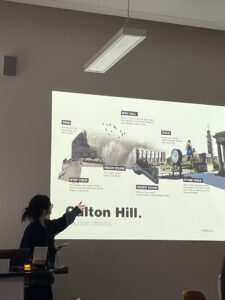Beyond the Visual
1.Self-reflection
How exactly do we measure the definition of colonisation in art and research, and on what
basis can we sympathise with Calton Hill? How do we know how it feels to be ‘colonised’
with our own ideas?
It got us to consider whether or not our hearing is effective by having us study Critical Modes of Listening.
if listening can be decolonized, and how can we colonial the voices around us? How could we
break down the links between sound and ethnicity, sound and colonial categories, and
dominance? We look at how artists are utilising sensory methods to promote various modes of
relating to the environment and one another.
“Some nations have colonized others, some cultures have appropriated others, some races and castes have colonized and enslaved others, some languages have overwritten others, some religions have annihilated dissimilarities, some ideologies have purged differences, some genders have ruled and oppressed others” (Arundhati Roy 2017)
Recognize local and global decolonization movements and explore postcolonial, decolonial, and intersectional ideas and practices. Collaborate with individuals and collectives in the field of art education. Focusing power to amplify voices and to differ
Each person finds a place indoors or outdoors close to or far from others. As each person becomes aware of the sound field from the environment, each person begins to individually and gradually reinforce the pitch of any sound source that attracts their attention (Oliveros, P. (2005)
Deep listening: sound exercises for composers)
Therefore, we chose listening as the object of observation.
By examining critical listening patterns, it prompts us to begin to consider whether our listening is colonizing the sounds around us, and whether it is possible to decolonize listening? How do we break down colonial categories and the correlation between sound and race, sound and domination? We examine how art can be used to connect people with nature, and how it can be used to create a sense of community. We also consider how art can be used to promote environmental awareness and stewardship.
2.Nature is about the strongest of the weak, and the so-called opposition to colonisation is
more about the entanglement of interests and conflicts of life and death between the same
species, whereas isn’t colonisation between different species beneficial and harmful?
Yet we ignore the trace elements that algae organisms bring into our diet. I think we can think of coral as a wall hanging that would allow users to choose to view the algae market in their homes for aesthetic purposes.
We should have looked at the whole complex of nature’s As we look to the future, it is important to remember that we are only one part of a larger ecosystem.
3.If there had been no human intervention, for example, on Calton Hill, it would have been a
small hill, probably a silent, dead place, without ancient buildings, without exhibitions,
without popularity, without anyone in the world knowing it existed, and perhaps wanting to
be the star of Edinburgh?
What Carlton Hill shows is that material and historical archaeology, human changes, collective memory, and economic values are closely linked.
on a typical trip to Calton Hill, with the auditory senses being somewhat of an aid, but in our research,
we use the auditory senses as the main factor in a decolonized perspective, exploring different ways
of connecting with the world beyond the visual senses.
Through our research, the colonialism and anthropocentrism embodied in Western scientism is
limiting. When we truly considered Calton Hill as a separate sensory-rich individual, we created a new
resonance and connection with Calton Hill in the form of hearing, producing a new sensory
relationship of understanding the world in bodily sensory mode, an imaginative embodiment of
relationship. We did not see the sensory mode dominated by the auditory senses as an extinction of
the visual senses, in the process of auditory attunements we formed images in the consciousness of
our own minds, as we saw in BLUE, creating an infinite visual universe with a static and pictureless
visual presentation.
This is the travel record chart I made





Calton Hill was perhaps first a huge volcanic rock, then it became a prehistoric mountain fort, then it was explored as a quarry, then as a mission it became a parish, then as a military site with a monastery, a cemetery and so on. Until now, small art galleries and museums have been built on top of it, hosting artistic events. People have been colonising Calton Hill, defining its existence in various cultural ways, and our vision is filled with these towering buildings, man-made landscapes and pictorial texts, but when one is standing on Calton Hill, listening to the birdsong, the sound of the mountain wind and leaves moving about and the unique scent of the seasons, Calton Hill is Calton Hill, and its separate connotations are particularly clear at this point It is a magical way of telling the story of its past, present and future in a way that speaks to the heart.
It’s great that you focused on Carleton Hill to write about. Even though all of us went to Calton Hill for the record, you did a really good job of completing it. I remember your presentation in class, and I appreciate the thought you provided about “beyond the visual”, which was very inspiring.
Great sound record, I seem to feel the wind from Calton Hill. The third part of the article is particularly well written, very poetic, and it is a very good artist’s text.